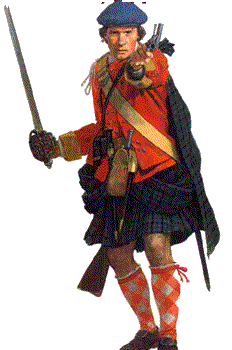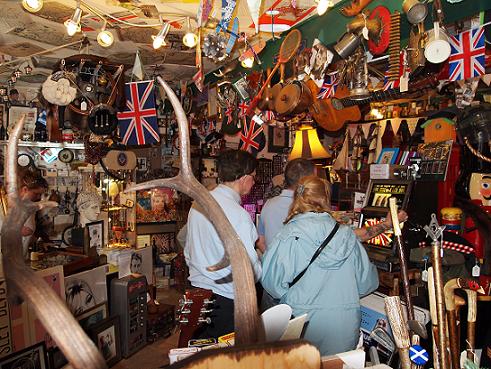Source 1 - The Krankies: Scottish pantomime act.

Source 2 - West Lothian's own Susan Boyle

All right. Calm down. Stop laughing now. The idea that any collection of 4-5 million people can all be "warriors" sounds pretty funny to modern people. Yet this idea that the Scots were naturally warlike was widely believed in 1914. It was a myth of course but like most myths it contained a few grains of truth.
Grain of Truth 1

Until the 19th century, Scotland had always been a poor country with strong trading links with Europe. There was a tradition of young Scots men seeking their fortune in France, the Netherlands, Germany, Poland and even Russia. Military service was part of that tradition, especially during the religious wars in Europe in the 17th century. This print shows Scots soldiers who fought in the attack on Stettin in the army of the Swedish king Gustavus Adolphus.
Grain of Truth 2

For centuries Scottish Highlanders had belonged to clan groups. Cattle stealing and fighting over clan territory was part of this until the battle of Culodden and the defeat of "Bonnie Prince Charlie". Laws passed such as the disarming Act were then passed by the UK government. They made the carrying of weapons (including bagpipes) illegal. Emigration from the Highlands then finished off the clan "system".
From the 1750s on, Highland Regiments had been formed to fight in the wars in North America against the French. The British Army General, James Wolfe famously commented ...
"They are hardy, intrepid, accustomed to a rough country, and it is
no great mischief if they fall."
Many more Highland and Lowland regiments were founded during the war of American independence and then against the French revolution and Napoleon. Recruitment into the Army was always needed to fight the Crimean war against Russia in 1856 and the wars of Empire in the late 19th century. Poverty was a great recruiter of both Highland and Lowland Scots. Paintings such as the one below helped to create the myth of the warrior race and were useful aids to recruitment also.
However, the myth WAS a myth. In the 19th century, Scottish regiments struggled to recruit sufficient men from the Highlands or the Lowlands. Often, they had to make up the numbers by recruiting from England and Ireland. The First World War was to change that.
The Charge of the Scots Greys at the Battle of Waterloo 1815.

Why was the "Warrior Myth" so powerful in 1914?
There were three major reasons for this ...

Hollywood actor Liam Neeson as "Rob Roy". The warrior myth still sells movie tickets!
1. Blame Sir Walter Scott! His historical novels such as "Waverley", "Rob Roy" and his poems "The Lay of the Last Minstrel" were huge blockbusters in the early 19th century. They created a massive world wide interest in Scotland and a tourist boom which has lasted to this day! Some historians have called Scott, "the man who invented Scotland". Composers like Mendelssohn wrote symphonies which were inspired by visits to Scotland and even Queen Victoria became obsessed after her husband Prince Albert bought a Highland home at Balmoral.
2. By 1914, Scotland had become an urban and industrial society. Most people had boring jobs (if they had jobs at all) in offices, factories etc. The idea that an office worker or shipyard labourer was part of a "warrior race" was bound to be flattering and popular. Historians have called this development "the invention of tradition."
3. Emigration from Scotland had a huge impact on Scottish culture at home. Scots emigrants in Canada, the USA, Australia etc were nostalgic for the "old country". This was often expressed by starting Caledonian Clubs and dressing in Highland dress. Most of these emigrants were lowland Scots but dressing up as Highlanders was much more romantic and impressive to the people they lived among in their new countries.
Watch this clip from the BBC series "A History of Scotland".
">